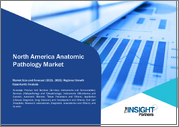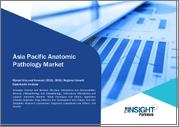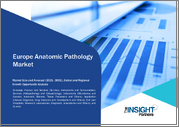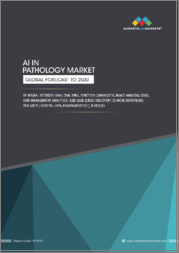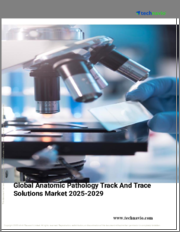
|
시장보고서
상품코드
1830507
해부 병리학 시장 : 제품, 기술, 용도, 최종사용자별 - 세계 예측(2025-2032년)Anatomic Pathology Market by Product, Technology, Application, End User - Global Forecast 2025-2032 |
||||||
해부 병리학 시장은 2032년까지 CAGR 7.78%로 673억 1,000만 달러로 성장할 것으로 예측됩니다.
| 주요 시장 통계 | |
|---|---|
| 기준 연도 2024년 | 369억 5,000만 달러 |
| 추정 연도 2025년 | 397억 8,000만 달러 |
| 예측 연도 2032 | 673억 1,000만 달러 |
| CAGR(%) | 7.78% |
집중화되는 기술과 임상적 요구가 어떻게 해부병리 진료를 재구성하고 이해관계자들에게 전략적 우선순위가 되고 있는지 설명하는 간결한 오리엔테이션
해부 병리학은 조직학, 분자과학, 디지털 혁신의 교차점에 위치하고 있으며, 진단, 연구, 치료에서 진화하는 해부 병리학의 역할은 전 세계 임상 워크플로우를 재구성하고 있습니다. 이 소개에서는 주요 요약의 범위와 의도를 제시하고, 변화의 핵심 동인, 디지털과 분자 양식의 융합, 검사실과 의료 시스템이 직면한 업무적 요구 사항을 강조합니다. 이후 분석은 투자, 파트너십, 역량 확장을 평가하는 의사결정권자에게 가장 관련성이 높은 기술 발전, 규제 영향, 상업적 역학의 종합으로 자리매김할 것입니다.
이 분야의 궤적은 이미지 분석과 분자 분석이 전통적인 염색 및 현미경 검사와 더 깊이 통합되는 것이 특징입니다. 그 결과, 검사실은 자동화, 데이터 상호운용성, 진단 정확도 향상 기회와 기존 프로세스를 조화시켜야 합니다. 따라서 이 소개서는 투자의 우선순위를 정하고, 위험을 관리하고, 영향력 있는 기술 도입을 가속화하는 방법에 대한 간결하고 증거에 기반한 관점을 필요로 하는 이해관계자들을 위해 이야기를 구성하고 있습니다. 또한, 세분화, 지역적 차이, 경쟁사 포지셔닝, 업계 리더를 위한 실용적인 제안 등 본 보고서를 통해 검토할 수 있는 렌즈를 구축했습니다.
디지털 컨버전스, 분자 통합, 운영 현대화 등 해부 병리학을 변화시키는 주요 트렌드에 대한 심층 분석
해부 병리학의 환경은 기술적 성숙, 노동력의 역동성, 지불자 및 규제 환경의 변화로 인해 혁신적인 변화가 일어나고 있습니다. 디지털 병리학은 틈새 능력에서 원격진료, 워크플로우 표준화, 이미지 기반 의사결정 지원을 위한 실용적인 플랫폼으로 발전하고 있으며, 그 결과 상호운용성과 안전한 데이터 저장의 가치가 증폭되고 있습니다. 동시에, 분자진단학 및 첨단 in situ 기술은 조직 수준에서 보다 풍부한 생물학적 특성을 평가할 수 있게함으로써 맞춤형 의료 및 동반진단을 위한 새로운 길을 열어가고 있습니다. 이러한 변화는 고립된 것이 아니라 서로 영향을 주고받으며 복합적으로 작용하기 때문에 적응력이 높은 검사 정보 시스템과 다양한 소스의 데이터를 오케스트레이션할 수 있는 통합 소프트웨어의 중요성이 커지고 있습니다.
업무적 측면에서, 검사실은 처리량과 처리시간의 추구와 진단 품질 및 규정 준수 유지의 필요성 사이에서 균형을 유지해야 합니다. 인력 부족과 진화하는 역량 요구사항은 자동화, 원격 협업 도구, 교육 프로그램에 대한 투자를 필요로 합니다. 재정적 측면에서 자본 배분 결정은 임상적 유용성 입증, 상환 경로, 측정 가능한 워크플로우 효율성에 점점 더 많은 영향을 받고 있습니다. 이러한 변화를 종합하면, 기술 상호운용성, 변경 관리, 증거 생성에 대한 전략적 접근이 지속적인 도입과 임상적 효과를 뒷받침할 수 있습니다.
최근 관세 개정이 해부학적 병리학적 환경에서 조달 탄력성, 공급업체 전략, 업무 연속성을 어떻게 재형성하는지 종합적으로 검토합니다.
무역 정책의 조정은 임상 검사에 필수적인 장비 및 시약의 조달 전략, 자본 계획, 공급망의 강인성에 중대한 영향을 미칠 수 있습니다. 최근 관세 변경과 그에 따른 규제 및 행정 조치로 인해 리드 타임, 공급업체 선정, 재고 관리에 영향을 미치고 기존 조달 채널에 마찰을 일으켰습니다. 이러한 환경에서 조달팀은 공급업체 다변화를 재평가하고, 가능하면 리쇼어링 및 니어쇼어링 옵션을 평가하고, 관세 및 통관 비용의 변동을 흡수할 수 있는 역동적인 구매 계약을 도입해야 합니다. 또한, 제조업체와 유통업체는 임상 고객에 대한 투명성과 연속성을 보장하기 위해 가격 전략과 계약 조건을 재검토해야 합니다.
계획의 관점에서 볼 때, 의료 시스템과 상업용 검사 시설은 재고의 가시성을 높이고 고 영향도 품목에 대한 비상 대응 프로토콜을 공식화하는 것이 좋습니다. 자본 취득 일정에는 세관 및 물류와 관련된 잠재적 지연을 포함시켜야 합니다. 한편, 임상 업무에서는 분석 성능을 유지할 수 있는 대체 시약과 장비의 선택지를 확인해야 합니다. 기기의 모델이나 시약의 공급처가 변경된 경우, 규제 문서 및 검증 계획도 업데이트가 필요할 수 있습니다. 궁극적으로 공급망 리스크 평가, 계약상 이해관계자 및 적극적인 이해관계자 커뮤니케이션을 결합한 적응형 접근 방식은 관세 중심의 불확실성에도 불구하고 업무의 혼란을 완화하고 진단의 연속성을 유지할 수 있습니다.
해부 병리학에 대한 투자 및 도입 경로를 안내하고, 제품, 기술, 용도, 최종사용자 역학에 대한 전략적 세분화 인사이트를 제공합니다.
제품 카테고리에 대한 미묘한 관점을 통해 임상과 상업적 기회가 교차하는 지점을 명확히 합니다. 장비, 시약 및 소모품, 서비스, 소프트웨어 솔루션은 진단 가치를 제공하고 워크플로우를 개선하는 데 있어 각각 뚜렷한 역할을 합니다. 장비는 슬라이드 제작, 영상 진단 및 분자 검사를 위한 물리적 플랫폼을 제공하고, 시약 및 소모품은 일상적인 진단 및 특수 분석에서 소비되며, 종종 재현성과 분석 감도를 결정합니다. 서비스, 설치, 유지보수, 실험실 아웃소싱에 이르기까지 소프트웨어 솔루션은 데이터 스트림을 통합하고, 품질 관리를 가능하게 하며, 규제 문서를 지원하는 결합 조직으로서 점점 더 많은 역할을 하고 있습니다.
기술 세분화는 차별화 된 채택 곡선과 가치 제안을 드러냅니다. 디지털 병리학은 서비스, 슬라이드 스캐너, 소프트웨어 솔루션, 스토리지 솔루션을 포괄하는 복합 카테고리로 부상하고 있으며, 기능적이고 확장 가능한 디지털 워크플로우에 필요한 각 구성요소를 포함하고 있습니다. 면역조직화학 및 특수 염색은 형태학적 및 단백질 발현 분석의 기초가 되며, 많은 질병 적응증에 대한 진단적 배경을 제공합니다. In situ hybridization과 분자진단학은 조직 형태학을 보완하는 핵산 수준의 인사이트를 제공하여 진단의 팔레트를 확장합니다. 이러한 기술 간의 상호 작용은 제품 개발 우선순위와 통합 전략에 반영됩니다.
용도별 인사이트에 따르면, 암 진단 분야에서는 고해상도 이미징과 다중화 분자 분석에 대한 수요가 지속적으로 증가하고 있으며, 유전질환 검사 및 감염성 질환 검사 분야에서는 민감도, 특이성, 처리량 간의 균형을 고려한 맞춤형 워크플로우가 요구되고 있습니다. 최종사용자 세분화에서는 학계 및 연구기관, 진단 연구소, 병원, 제약 및 생명공학 기업에서 각기 다른 구매 행태와 도입 일정을 확인했습니다.
인프라, 규제, 임상 수요의 지리적 차이가 해부병리 도입 및 전략에 미치는 영향에 대해 지역별로 상세한 전망을 제시합니다.
지역 역학은 임상 우선순위, 상환 메커니즘, 인프라 준비에 영향을 미치며, 지역 간 혁신이 어떻게 전개되는지를 형성합니다. 아메리카에서는 이미 구축된 실험실 네트워크와 정밀 종양학에 대한 높은 관심이 통합 디지털 및 분자 솔루션에 대한 수요를 창출하고 있으며, 대규모 표준 실험실은 통합 및 표준화 노력을 추진하고 있습니다. 이 지역의 규제 경로와 지불자 모델 또한 임상적 유용성을 입증하고 실제 증거를 생성하는 데 인센티브를 제공하고 있으며, 이는 채택 속도와 상용화 계획에 반영됩니다.
유럽, 중동 및 아프리카는 고도의 역량을 갖춘 센터와 자원에 제약이 있는 환경이 공존하는 이질적인 지역이며, 이러한 차이로 인해 다양한 인프라 수준에서 운영할 수 있는 확장 가능한 솔루션에 대한 수요가 증가하고 있습니다. 국경을 초월한 협력과 범지역적 참조 서비스는 디지털 병리학과 원격진료로 지원되어 전문의에 대한 접근과 사례 분포를 최적화하는 데 도움을 주며 보편화되고 있습니다. 지역별 규제 프레임워크와 상환 관행에 따라 각 지역에 맞는 시장 진입 전략과 근거 자료가 필요합니다.
아시아태평양에서는 헬스케어 인프라에 대한 급속한 투자와 임상 연구 기반 확대에 따라 선진 병리 기술의 도입이 가속화되고 있지만, 도입 속도는 국가와 의료 시스템의 성숙도에 따라 차이가 있습니다. 수입 규제를 극복하고 비용 효율적으로 전개하기 위해서는 현지 제조 및 판매 파트너십이 필수적입니다. 전 지역을 아우르는 주제는 데이터 거버넌스 프레임워크의 필요성, 인재 육성에 대한 투자, 다기관 협력과 새로운 진단 기능의 확장 가능한 배포를 지원하는 상호 운용 시스템 구축 등을 꼽을 수 있습니다.
해부학 병리학의 발전에서 통합 공급업체, 전문 혁신가, 서비스 파트너의 역할에 초점을 맞추고, 실용적인 경쟁 상황 인사이트
해부 병리학의 경쟁 역학은 수직적으로 통합된 진단 제공업체, 이미징 및 분자 도구에 특화된 전문 벤더, 신흥 소프트웨어 및 인공지능 기업이 혼재되어 있는 것이 특징입니다. 기존 기기 및 시약 제조업체는 규모와 규제 경험을 바탕으로 광범위한 임상 개발을 지원하는 반면, 민첩한 틈새 시장 기업은 특정 통증 포인트에 대한 특수 분석, 워크플로우 자동화, 분석 플랫폼으로 차별화를 꾀하고 있습니다. 하드웨어의 견고함과 고급 데이터 처리를 결합한 엔드 투 엔드 솔루션에 대한 시장의 요구를 반영하여, 장비 제조업체와 소프트웨어 공급업체 간의 파트너십 및 전략적 제휴가 점점 더 보편화되고 있습니다.
제3자 병리 검사 네트워크 및 위탁 검사 기관과 같은 서비스 제공업체는 고급 검사에 대한 접근을 가능하게 하고 도입 전문 지식을 제공하는 데 중요한 역할을 합니다. 마찬가지로, 검증 및 규제 관련 컨설팅을 제공하는 기업은 고객이 복잡한 승인 경로와 품질 시스템 요구 사항을 극복하는 데 매우 중요합니다. 경쟁 환경은 상호운용성, 시장 출시 후 강력한 지원, 임상 통합을 위한 명확한 경로를 제시할 수 있는 기업, 특히 진단의 유용성과 워크플로우의 효율성을 보여주는 증거에 접근할 수 있는 기업에게 보상을 제공합니다. 구매자의 경우, 벤더를 선택할 때 생태계 호환성, 장기적인 제품 로드맵, 조직의 목표에 부합하는 확장 가능한 지원 서비스 제공 여부가 점점 더 우선순위가 되고 있습니다.
병리 업무에 디지털, 분자, 자동화 전략을 지속가능하게 도입할 수 있도록 조직 리더에게 실질적이고 영향력 있는 제안을 제공합니다.
업계 리더들은 단기적인 임상적 요구와 장기적인 전략적 역량 구축의 균형을 고려한 투자를 우선순위에 두어야 합니다. 첫째, 디지털 이니셔티브를 포인트 솔루션이 아닌 생태계로 계획하고 슬라이드 스캐닝, 소프트웨어, 스토리지, 서비스를 연계하여 측정 가능한 워크플로우 개선과 임상의의 도입을 실현하는 것입니다. 둘째, 인력의 제약에 대응하고 진단의 질을 떨어뜨리지 않고 처리량을 향상시키기 위해 모듈식 자동화에 투자합니다. 자동화 결정은 도입 촉진을 위한 검증 연구와 통합된 교육 프로그램을 통해 정보를 제공해야 합니다. 셋째, 다양한 조달처, 전략적 재고 관리, 관세 및 물류 변동성을 완화하는 계약 메커니즘을 통해 공급망의 강인성을 강화합니다.
또한, 리더는 임상 연구자 및 의료경제학 팀과의 파트너십을 활용하여 새로운 분석법 및 플랫폼의 임상적 유용성과 비용 효율성을 입증할 수 있는 강력한 사용 사례 문서를 구축함으로써 새로운 분석법 및 플랫폼의 임상적 유용성과 비용 효율성을 입증할 수 있는 증거를 생성하는 데 집중해야 합니다. 동시에, 시범 도입, 로컬 챔피언, 워크플로우 개선을 위한 지속적인 피드백 루프를 포함한 단계적 변경 관리 전략을 채택합니다. 마지막으로, 상호운용성 및 데이터 거버넌스 기능을 구축하여 안전한 다기관 협업, AI 통합, 진화하는 개인정보 보호 규정 준수를 가능하게 합니다. 이러한 우선순위는 조직이 기술적 잠재력을 지속가능한 임상적, 업무적 이익으로 전환하는 데 도움이 됩니다.
전문가 인터뷰, 문헌 통합, 반복 검증을 결합한 혼합 방법론적 연구 접근법을 투명하게 설명하여 견고하고 신뢰할 수 있는 연구 결과를 보장합니다.
본 Executive Summary의 기초가 되는 연구는 질적 전문가 참여, 여러 출처의 문헌 통합, 구조화된 검증을 결합하여 균형 잡힌 지식을 얻었습니다. 1차 조사로 임상 검사부장, 임상병리사, 조달 책임자, 업계 임원과의 인터뷰를 통해 도입 과제, 임상적 우선순위, 조달 의사결정 요인에 대한 생생한 관점을 파악했습니다. 이러한 대화를 통해 주요 주제들이 도출되었고, 운영상의 제약, 규제적 고려사항, 기술 수용성 등 공개된 자료에서는 잘 드러나지 않는 요소들이 부각되었습니다.
2차 조사에서는 기술 역량을 명확히 하고, 문서화된 임상적 성과를 확인하기 위해 동료평가 문헌, 규제 지침, 업계 백서를 체계적으로 검토했습니다. 도출된 결과는 정보원 간 삼자대립을 통해 검증하고, 후속 전문가 협의를 통해 일관성을 확보하는 한편, 의견 차이를 조정했습니다. 적절한 경우, 지역 간 공식 보고의 편차, 빠르게 진화하는 제품 역량 및 규제적 위치 등 조사 방법론의 한계에 대해서도 언급했습니다. 프로세스 전반에 걸쳐 가정의 투명성, 분석 단계의 재현성, 인터뷰 중 수집된 기밀 정보의 윤리적 취급에 중점을 두었습니다.
통합된 데이터 기반 해부 병리학 역량을 실현하기 위한 전략적 필수 사항과 기회를 간결하게 요약한 결론.
요약 : 해부 병리학은 전통적인 병리조직학과 분자생물학적 및 디지털 기법을 융합한 통합된 데이터 기반 진단 생태계로 전환하고 있습니다. 이러한 기술의 융합은 진단 정확도 향상, 워크플로우 간소화, 전문가에 대한 접근성 확대라는 분명한 기회를 제공합니다. 그러나 이러한 가능성을 실현하기 위해서는 상호운용성, 인적자원 개발, 공급망의 견고성, 임상적 및 경제적 가치를 뒷받침하는 증거 창출 등에 충분한 주의를 기울여야 합니다.
따라서 학계, 임상 검사실, 병원, 산업계의 이해관계자들은 기술 투자를 검증된 임상 사용 사례와 지속가능한 운영 모델에 맞게 조정하는 협력 전략을 채택해야 합니다. 확장 가능한 아키텍처, 견고한 검증 경로, 협업적 실행 방식에 중점을 둠으로써 조직은 규제 및 상업적 복잡성을 극복하고 환자 치료 및 검사실 효율성에 실질적인 개선을 가져올 수 있습니다. 이러한 접근 방식의 성과는 정밀의료의 진화하는 요구에 부응할 수 있는 보다 탄력적이고 적응력이 뛰어난 해부병리 생태계를 구축할 수 있습니다.
목차
제1장 서문
제2장 조사 방법
제3장 주요 요약
제4장 시장 개요
제5장 시장 인사이트
제6장 미국 관세의 누적 영향 2025
제7장 AI의 누적 영향 2025
제8장 해부 병리학 시장 : 제품별
- 기기
- 시약과 소모품
- 서비스
- 소프트웨어 솔루션
제9장 해부 병리학 시장 : 기술별
- 디지털 병리학
- 서비스
- 슬라이드 스캐너
- 소프트웨어 솔루션
- 스토리지 솔루션
- 면역조직화학
- ISH(In Situ Hybridization)
- 분자진단
- 특수 염색
제10장 해부 병리학 시장 : 용도별
- 암 진단
- 유전성 질환
- 감염증
제11장 해부 병리학 시장 : 최종사용자별
- 학술조사기관
- 진단 검사실
- 병원
- 제약·바이오테크놀러지 기업
제12장 해부 병리학 시장 : 지역별
- 아메리카
- 북미
- 라틴아메리카
- 유럽, 중동 및 아프리카
- 유럽
- 중동
- 아프리카
- 아시아태평양
제13장 해부 병리학 시장 : 그룹별
- ASEAN
- GCC
- EU
- BRICS
- G7
- NATO
제14장 해부 병리학 시장 : 국가별
- 미국
- 캐나다
- 멕시코
- 브라질
- 영국
- 독일
- 프랑스
- 러시아
- 이탈리아
- 스페인
- 중국
- 인도
- 일본
- 호주
- 한국
제15장 경쟁 구도
- 시장 점유율 분석, 2024
- FPNV 포지셔닝 매트릭스, 2024
- 경쟁 분석
- Thermo Fisher Scientific Inc.
- Danaher Corporation
- F. Hoffmann-La Roche Ltd
- Agilent Technologies, Inc.
- Siemens Healthineers AG
- PerkinElmer, Inc.
- Becton, Dickinson and Company
- Bio-Rad Laboratories, Inc.
- Sysmex Corporation
- QIAGEN N.V.
The Anatomic Pathology Market is projected to grow by USD 67.31 billion at a CAGR of 7.78% by 2032.
| KEY MARKET STATISTICS | |
|---|---|
| Base Year [2024] | USD 36.95 billion |
| Estimated Year [2025] | USD 39.78 billion |
| Forecast Year [2032] | USD 67.31 billion |
| CAGR (%) | 7.78% |
Concise orientation explaining how converging technologies and clinical demands are reshaping anatomic pathology practices and strategic priorities for stakeholders
Anatomic pathology sits at the intersection of histology, molecular science, and digital innovation, and its evolving roles in diagnostics, research, and therapeutics continue to reshape clinical workflows worldwide. This introduction presents the scope and intent of the executive summary, highlighting core drivers of change, the convergence of digital and molecular modalities, and the operational demands facing laboratories and health systems. It positions the subsequent analysis as a synthesis of technological advances, regulatory influences, and commercial dynamics that are most relevant to decision-makers evaluating investments, partnerships, and capability expansion.
The field's trajectory is characterized by deeper integration of image analytics and molecular assays with traditional staining and microscopy practices. As a result, laboratories must reconcile legacy processes with opportunities for automation, data interoperability, and augmented diagnostic accuracy. This introduction therefore frames the narrative for stakeholders who require a concise, evidence-informed perspective on how to prioritize investments, manage risk, and accelerate implementation of high-impact technologies. It also establishes the lens through which the report examines segmentation, regional differences, competitive positioning, and actionable recommendations for industry leaders.
Detailed analysis of the major transformative trends reshaping anatomic pathology including digital convergence, molecular integration, and operational modernization
The anatomic pathology landscape is undergoing transformative shifts driven by technological maturation, workforce dynamics, and changing payer and regulatory environments. Digital pathology has progressed from a niche capability to a pragmatic platform for remote consultation, workflow standardization, and image-based decision support, which in turn amplifies the value of interoperability and secure data storage. Concurrently, molecular diagnostics and advanced in situ techniques are enabling richer biologic characterization at the tissue level, creating new pathways for personalized medicine and companion diagnostics. These shifts are not isolated; they interact and compound one another, elevating the importance of adaptable laboratory information systems and integrated software that can orchestrate data from diverse sources.
Operationally, laboratories are balancing the push for throughput and turnaround time with the need to maintain diagnostic quality and regulatory compliance. Workforce shortages and evolving competency requirements necessitate investments in automation, remote collaboration tools, and training programs that can preserve institutional expertise while increasing capacity. Financially, capital allocation decisions are increasingly influenced by demonstrable clinical utility, reimbursement pathways, and measurable workflow efficiencies. Taken together, these transformative changes call for a strategic approach that addresses technology interoperability, change management, and evidence generation to support sustained adoption and clinical impact.
Comprehensive examination of how recent tariff changes reshape procurement resilience, supplier strategies, and operational continuity in anatomic pathology settings
Trade policy adjustments can materially affect procurement strategies, capital planning, and supply chain resilience for laboratory-critical equipment and reagents. Recent tariff changes and the attendant regulatory and administrative measures have introduced friction into established sourcing channels, with implications for lead times, vendor selection, and inventory management. This environment requires procurement teams to reassess supplier diversification, to evaluate reshoring or nearshoring options where feasible, and to implement dynamic purchasing contracts that can absorb variations in duties and clearance costs. In addition, manufacturers and distributors must revisit pricing strategies and contractual terms to ensure transparency and continuity for clinical customers.
From a planning perspective, health systems and commercial laboratories are advised to increase inventory visibility and to formalize contingency protocols for high-impact items. Capital acquisition timelines should incorporate potential delays related to customs and logistics, while clinical operations should identify alternative reagent or instrument options that maintain analytical performance. Regulatory documentation and validation plans may also need updating when equipment models or reagent sources change. Ultimately, an adaptable approach that combines supply chain risk assessment, contractual safeguards, and proactive stakeholder communication will mitigate operational disruption and preserve diagnostic continuity in the face of tariff-driven uncertainty.
Strategic segmentation insights illuminating product, technology, application, and end-user dynamics that guide investment and adoption pathways in anatomic pathology
A nuanced view of product categories clarifies where clinical and commercial opportunities intersect. Instruments, reagents and consumables, services, and software solutions each play distinct roles in delivering diagnostic value and enabling workflow improvements. Instruments provide the physical platforms for slide preparation, imaging, and molecular testing, while reagents and consumables are consumed in routine diagnostics and specialized assays, often dictating repeatability and analytical sensitivity. Services span installation, maintenance, and laboratory outsourcing arrangements, and software solutions increasingly act as the connective tissue that integrates data streams, enables quality control, and supports regulatory documentation.
Technology segmentation reveals differentiated adoption curves and value propositions. Digital pathology emerges as a composite category encompassing services, slide scanners, software solutions, and storage solutions, each component necessary for a functional and scalable digital workflow. Immunohistochemistry and special staining remain foundational for morphological and protein expression analyses, providing established diagnostic context for many disease indications. In situ hybridization and molecular diagnostics expand the diagnostic palette, offering nucleic acid-level insights that complement histomorphology. The interplay between these technologies informs product development priorities and integration strategies.
Application-focused insights show that cancer diagnostics continues to drive demand for high-resolution imaging and multiplexed molecular assays, while genetic disorder testing and infectious disease applications require tailored workflows that balance sensitivity, specificity, and throughput. End-user segmentation highlights distinct purchasing behaviors and implementation timelines across academic and research institutes, diagnostic laboratories, hospitals, and pharmaceuticals and biotechnology companies, each setting presenting specific regulatory, operational, and evidence requirements that influence technology adoption and commercial engagement strategies.
In-depth regional perspective on how geographic differences in infrastructure, regulation, and clinical demand influence anatomic pathology adoption and strategy
Regional dynamics influence clinical priorities, reimbursement mechanisms, and infrastructure readiness, shaping how innovations are deployed across geographies. In the Americas, established laboratory networks and a strong emphasis on precision oncology create demand for integrated digital and molecular solutions, while large reference laboratories drive consolidation and standardization efforts. Regulatory pathways and payer models in this region also incentivize demonstrable clinical utility and real-world evidence generation, which informs adoption pacing and commercialization planning.
The Europe, Middle East & Africa region presents a heterogeneous landscape where high-capability centers coexist with resource-constrained settings; this variance drives demand for scalable solutions that can operate across differing infrastructure levels. Cross-border collaboration and pan-regional reference services are becoming more common, supported by digital pathology and teleconsultation, which helps optimize specialist access and case distribution. Region-specific regulatory frameworks and reimbursement practices require tailored market access strategies and evidence dossiers.
In Asia-Pacific, rapid investments in healthcare infrastructure and an expanding clinical research base are accelerating uptake of advanced pathology technologies, but adoption rates vary by country and by health system maturity. Local manufacturing and distribution partnerships can be critical to navigate import regulations and achieve cost-effective deployment. Across all regions, cross-cutting themes include the need for data governance frameworks, investments in workforce training, and the creation of interoperable systems that support multi-site collaboration and scalable deployment of new diagnostic capabilities.
Actionable competitive landscape insights highlighting the roles of integrated suppliers, specialized innovators, and service partners in anatomic pathology advancement
Competitive dynamics in anatomic pathology are characterized by a mix of vertically integrated diagnostics providers, specialized vendors focused on imaging or molecular tools, and emerging software and artificial intelligence companies. Established instrument and reagent manufacturers continue to leverage scale and regulatory experience to support broad clinical deployments, while nimble niche players differentiate through specialized assays, workflow automation, or analytic platforms that address specific pain points. Partnerships and strategic alliances between instrument makers and software vendors are increasingly common, reflecting the market's need for end-to-end solutions that combine hardware robustness with advanced data processing.
Service providers, including third-party pathology networks and contract laboratory organizations, play a critical role in enabling access to sophisticated testing and in providing implementation expertise. Similarly, companies that offer validation and regulatory consulting are pivotal when customers navigate complex approval pathways and quality system requirements. The competitive landscape rewards firms that can demonstrate interoperability, strong post-market support, and clear pathways for clinical integration, particularly where evidence of diagnostic utility and workflow efficiency are accessible. For purchasers, vendor selection increasingly prioritizes ecosystem compatibility, long-term product roadmaps, and the availability of scalable support services that align with institutional goals.
Practical, high-impact recommendations for organizational leaders to enable sustainable adoption of digital, molecular, and automation strategies in pathology operations
Industry leaders should prioritize investments that balance near-term clinical needs with long-term strategic capability building. First, ensure that digital initiatives are planned as ecosystems rather than point solutions, where slide scanning, software, storage, and services are aligned to deliver measurable workflow improvements and clinician adoption. Second, invest in modular automation to address workforce constraints and to improve throughput without compromising diagnostic quality; automation decisions should be informed by validation studies and integrated training programs to accelerate uptake. Third, strengthen supply chain resilience through diversified sourcing, strategic inventory management, and contractual mechanisms that mitigate tariff and logistics volatility.
Leaders should also focus on evidence generation that demonstrates clinical utility and cost-effectiveness for new assays and platforms, leveraging partnerships with clinical investigators and health economics teams to build robust use-case documentation. In parallel, adopt a phased change-management strategy that includes pilot implementations, local champions, and continuous feedback loops to refine workflows. Finally, build interoperability and data governance capabilities to enable secure multi-site collaboration, AI integration, and compliance with evolving privacy regulations. These priorities will help organizations convert technological potential into sustainable clinical and operational benefits.
Transparent description of a mixed-methods research approach combining expert interviews, literature synthesis, and iterative validation to ensure robust and credible findings
The research underpinning this executive summary combined qualitative expert engagement, multi-source literature synthesis, and structured validation to produce balanced insights. Primary research included interviews with laboratory directors, clinical pathologists, procurement leaders, and industry executives to capture first-hand perspectives on adoption challenges, clinical priorities, and procurement decision drivers. These conversations informed key themes and helped surface operational constraints, regulatory considerations, and technology acceptance factors that are not always evident from published materials.
Secondary research involved systematic review of peer-reviewed literature, regulatory guidance, and industry white papers to contextualize technological capabilities and to identify documented clinical outcomes. Findings were triangulated across sources and validated through follow-up expert consultations to ensure consistency and to reconcile divergent viewpoints. Where appropriate, methodological limitations are acknowledged, including variability in public reporting across regions and the rapidly evolving nature of product capabilities and regulatory positions. Throughout the process, emphasis was placed on transparency of assumptions, reproducibility of analytic steps, and the ethical handling of sensitive information gathered during interviews.
Concise conclusion summarizing the strategic imperatives and opportunities for realizing integrated, data-driven anatomic pathology capabilities
In summary, anatomic pathology is transitioning toward integrated, data-driven diagnostic ecosystems that combine traditional histopathology with molecular and digital modalities. The convergence of these technologies offers clear opportunities to enhance diagnostic accuracy, streamline workflows, and expand access to specialist expertise. However, realizing this potential requires thoughtful attention to interoperability, workforce development, supply chain resilience, and evidence generation that supports clinical and economic value.
Stakeholders across academia, clinical laboratories, hospitals, and industry must therefore adopt coordinated strategies that align technology investments with validated clinical use cases and sustainable operational models. By emphasizing scalable architectures, robust validation pathways, and collaborative implementation practices, organizations can navigate regulatory and commercial complexities to deliver tangible improvements in patient care and laboratory efficiency. The outcome of such an approach is a more resilient, adaptable anatomic pathology ecosystem capable of meeting the evolving demands of precision medicine.
Table of Contents
1. Preface
- 1.1. Objectives of the Study
- 1.2. Market Segmentation & Coverage
- 1.3. Years Considered for the Study
- 1.4. Currency & Pricing
- 1.5. Language
- 1.6. Stakeholders
2. Research Methodology
3. Executive Summary
4. Market Overview
5. Market Insights
- 5.1. Implementation of artificial intelligence algorithms for automated tissue slide analysis and diagnostic support
- 5.2. Adoption of cloud-based digital pathology platforms enabling remote consultation and collaborative diagnostics
- 5.3. Integration of next generation sequencing assays into routine anatomic pathology workflows for personalized medicine
- 5.4. Rising utilization of liquid biopsy techniques for noninvasive molecular profiling in cancer pathology diagnostics
- 5.5. Advancements in multiplex immunohistochemistry for comprehensive tumor microenvironment characterization in pathology labs
6. Cumulative Impact of United States Tariffs 2025
7. Cumulative Impact of Artificial Intelligence 2025
8. Anatomic Pathology Market, by Product
- 8.1. Instruments
- 8.2. Reagents & Consumables
- 8.3. Services
- 8.4. Software Solutions
9. Anatomic Pathology Market, by Technology
- 9.1. Digital Pathology
- 9.1.1. Services
- 9.1.2. Slide Scanners
- 9.1.3. Software Solutions
- 9.1.4. Storage Solutions
- 9.2. Immunohistochemistry
- 9.3. In Situ Hybridization
- 9.4. Molecular Diagnostics
- 9.5. Special Staining
10. Anatomic Pathology Market, by Application
- 10.1. Cancer Diagnostics
- 10.2. Genetic Disorders
- 10.3. Infectious Disease
11. Anatomic Pathology Market, by End User
- 11.1. Academic & Research Institutes
- 11.2. Diagnostic Laboratories
- 11.3. Hospitals
- 11.4. Pharmaceuticals & Biotechnology Companies
12. Anatomic Pathology Market, by Region
- 12.1. Americas
- 12.1.1. North America
- 12.1.2. Latin America
- 12.2. Europe, Middle East & Africa
- 12.2.1. Europe
- 12.2.2. Middle East
- 12.2.3. Africa
- 12.3. Asia-Pacific
13. Anatomic Pathology Market, by Group
- 13.1. ASEAN
- 13.2. GCC
- 13.3. European Union
- 13.4. BRICS
- 13.5. G7
- 13.6. NATO
14. Anatomic Pathology Market, by Country
- 14.1. United States
- 14.2. Canada
- 14.3. Mexico
- 14.4. Brazil
- 14.5. United Kingdom
- 14.6. Germany
- 14.7. France
- 14.8. Russia
- 14.9. Italy
- 14.10. Spain
- 14.11. China
- 14.12. India
- 14.13. Japan
- 14.14. Australia
- 14.15. South Korea
15. Competitive Landscape
- 15.1. Market Share Analysis, 2024
- 15.2. FPNV Positioning Matrix, 2024
- 15.3. Competitive Analysis
- 15.3.1. Thermo Fisher Scientific Inc.
- 15.3.2. Danaher Corporation
- 15.3.3. F. Hoffmann-La Roche Ltd
- 15.3.4. Agilent Technologies, Inc.
- 15.3.5. Siemens Healthineers AG
- 15.3.6. PerkinElmer, Inc.
- 15.3.7. Becton, Dickinson and Company
- 15.3.8. Bio-Rad Laboratories, Inc.
- 15.3.9. Sysmex Corporation
- 15.3.10. QIAGEN N.V.









